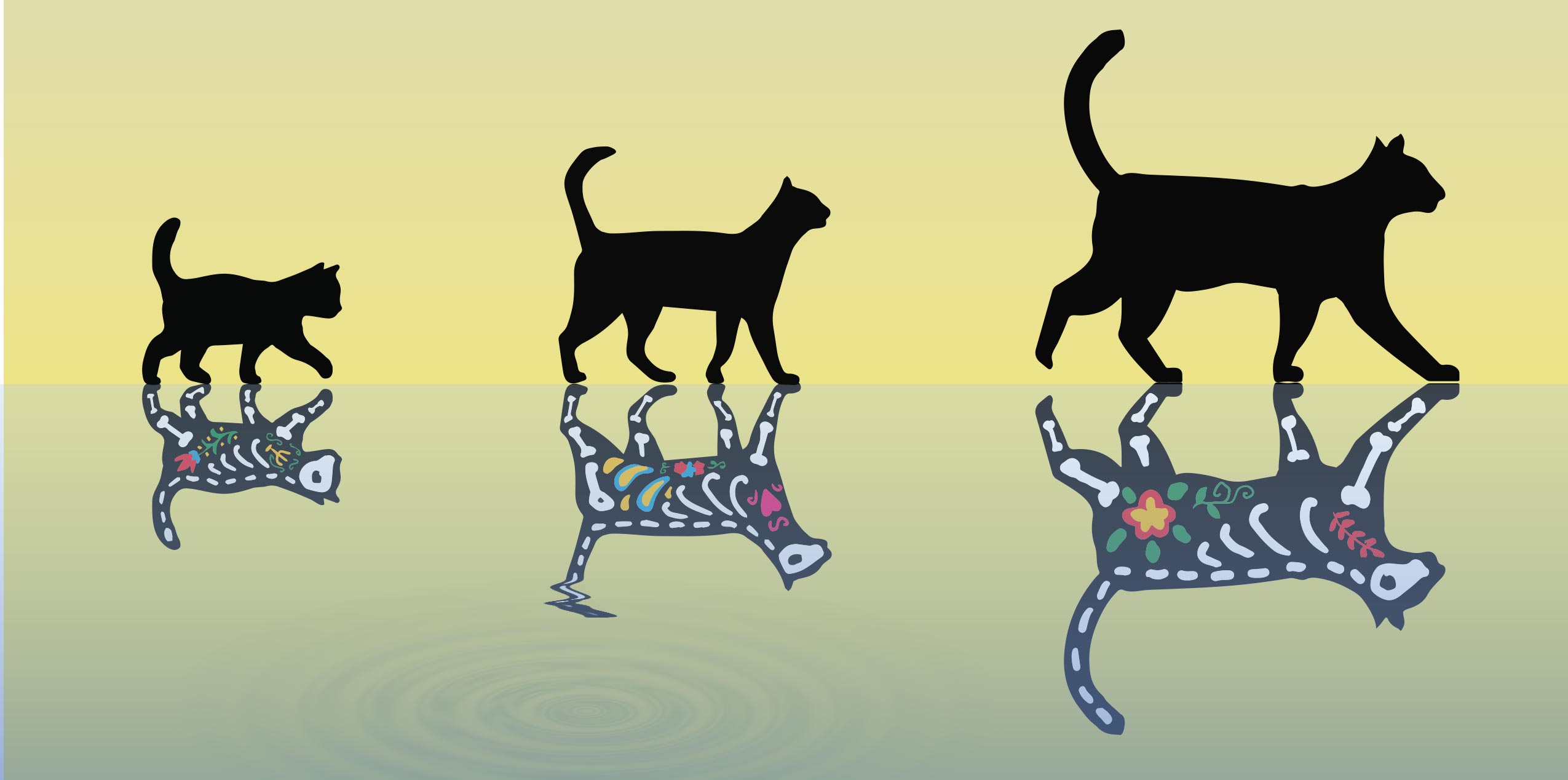

ETH Zürih’teki bilim adamları, aynı anda hem canlı (üstte) hem de ölü (altta) olabilen Schrödinger’in daha ağır kedilerini yaratmada ilerleme kaydettiler. Kredi: Yiwen Chu / ETH Zürih
ETH Zürih’teki araştırmacılar, iki salınım halinin üst üste bindirildiği bir kristal yerleştirerek şimdiye kadarki en ağır Schrödinger’in kedisini yarattılar. Sonuçları, daha güçlü kübitlere yol açabilir ve kübitlerin günlük yaşamda neden gözlemlenmediğini açıklamaya yardımcı olabilir.
- ETH Zürih’teki araştırmacılar, Schrödinger’in şimdiye kadarki en ağır kedisini yarattılar.
- Bunun için, salınan bir kristali süper iletken bir devre ile birleştirdiler.
- Makroskobik dünyada kuantum etkilerinin neden ortadan kaybolduğunu daha iyi anlamayı umuyorlar.
Kuantum fizikçisi olmasanız bile, muhtemelen Schrödinger’in ünlü kedisini duymuşsunuzdur. Erwin Schrödinger, 1935’te bir düşünce deneyinde aynı anda hem canlı hem de ölü olabilen kediler buldu. Bariz paradoks – sonuçta, günlük hayatta sadece canlı ya da canlı olan kedileri görüyoruz. veya Ölü – bilim adamlarını laboratuvarda benzer durumları gerçekleştirmeye çalışmaya teşvik etti. Şimdiye kadar bunu, örneğin atomları veya molekülleri kuantum mekanik süperpozisyon durumlarında aynı anda iki yerde olma durumlarında kullanarak yapabildiler.
ETH’de, Katı Hal Fiziği Laboratuvarı’nda profesör olan Yiwen Chu liderliğindeki bir araştırma ekibi, küçük bir kristali iki salınım halinin süperpozisyonuna yerleştirerek çok daha ağır bir Schrödinger kedisi yarattı. Science dergisinde bu hafta yayınlanan sonuçları, daha güçlü kübitlere yol açabilir ve makroskobik dünyada neden kuantum süperpozisyonlarının gözlemlenmediğinin gizemine ışık tutabilir.
bir kutudaki kedi
Schrödinger’in orijinal düşünce deneyinde bir kedi, içinde radyoaktif madde, bir Geiger sayacı ve bir şişe zehir bulunan metal bir kutunun içine kapatılır. Belirli bir zaman diliminde – örneğin bir saat -[{” attribute=””>atom in the substance may or may not decay through a quantum mechanical process with a certain probability, and the decay products might cause the Geiger counter to go off and trigger a mechanism that smashes the flask containing the poison, which would eventually kill the cat. Since an outside observer cannot know whether an atom has actually decayed, he or she also doesn’t know whether the cat is alive or dead – according to quantum mechanics, which governs the decay of the atom, it should be in an alive/dead superposition state. (Schrödinger’s idea is commemorated by a life-size cat figure outside his former home at Huttenstrasse 9 in Zurich).

In the ETH Zurich experiment, the cat is represented by oscillations in a crystal (top and blow-up on the left), whereas the decaying atom is emulated by a superconducting circuit (bottom) coupled to the crystal. Credit: Yiwen Chu / ETH Zurich
“Of course, in the lab we can’t realize such an experiment with an actual cat weighing several kilograms,” says Chu. Instead, she and her co-workers managed to create a so-called cat state using an oscillating crystal, which represents the cat, with a superconducting circuit representing the original atom. That circuit is essentially a quantum bit or qubit that can take on the logical states “0” or “1” or a superposition of both states, “0+1”. The link between the qubit and the crystal “cat” is not a Geiger counter and poison, but rather a layer of piezoelectric material that creates an electric field when the crystal changes shape while oscillating. That electric field can be coupled to the electric field of the qubit, and hence the superposition state of the qubit can be transferred to the crystal.
Simultaneous oscillations in opposite directions
As a result, the crystal can now oscillate in two directions at the same time – up/down and down/up, for instance. Those two directions represent the “alive” or “dead” states of the cat. “By putting the two oscillation states of the crystal in a superposition, we have effectively created a Schrödinger cat weighing 16 micrograms,” explains Chu. That is roughly the mass of a fine grain of sand and nowhere near that of a cat, but still several billion times heavier than an atom or molecule, making it the fattest quantum cat to date.
In order for the oscillation states to be true cat states, it is important that they be macroscopically distinguishable. This means that the separation of the “up” and “down” states should be larger than any thermal or quantum fluctuations of the positions of the atoms inside the crystal. Chu and her colleagues checked this by measuring the spatial separation of the two states using the superconducting qubit. Even though the measured separation was only a billionth of a billionth of a meter – smaller than an atom, in fact – it was large enough to clearly distinguish the states.
Measuring small disturbances with cat states
In the future, Chu would like to push the mass limits of her crystal cats even further. “This is interesting because it will allow us to better understand the reason behind the disappearance of quantum effects in the macroscopic world of real cats,” she says. Beyond this rather academic interest, there are also potential applications in quantum technologies. For instance, quantum information stored in qubits could be made more robust by using cat states made up of a huge number of atoms in a crystal rather than relying on single atoms or ions, as is currently done. Also, the extreme sensitivity of massive objects in superposition states to external noise could be exploited for precise measurements of tiny disturbances such as gravitational waves or for detecting dark matter.
Reference: “Schrödinger cat states of a 16-microgram mechanical oscillator” by Marius Bild, Matteo Fadel, Yu Yang, Uwe von Lüpke, Phillip Martin, Alessandro Bruno and Yiwen Chu, 20 April 2023, Science.
DOI: 10.1126/science.adf7553

“Analist. Tutkulu zombi gurusu. Twitter uygulayıcısı. İnternet fanatiği. Dost pastırma hayranı.”





More Stories
Bilim insanları dünyadaki en büyük demir cevheri yataklarında milyar yıllık bir sırrı keşfetti
Fosillere göre tarih öncesi deniz ineği, timsah ve köpekbalığı tarafından yenildi
Büyük bir bindirme fayı üzerine yapılan yeni araştırma, bir sonraki büyük depremin yakın olabileceğini gösteriyor